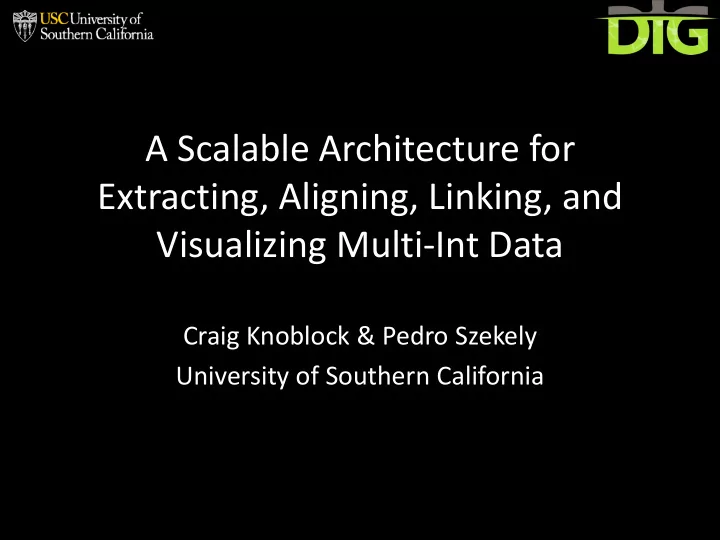

A Scalable Architecture for Extracting, Aligning, Linking, and Visualizing Multi-Int Data Craig Knoblock & Pedro Szekely University of Southern California
Introduction • Massive quantities of data available for analysis – OSING, HUMINT, SIGINT, MASINT, GEOINT, … • Data is spread across multiple sources, multiple sites and multiple formats – Databases, text, web sites, XML, JSON, etc... • If an analyst could exploit all of this data, it could transform analysis – Disruptive technology for analysis University of Southern California 2
Solution: Domain-specific Insight Graphs • Innovative architecture – Extracting, aligning, linking, and visualizing massive amounts of data – Domain-specific content from structured and unstructured sources • State-of-the art open source software – Open architecture with flexible APIs – Cloud-based infrastructure (HDFS, Hadoop, ElasticSearch, etc.) University of Southern California 3
Example Scenario • Want to determine the nuclear know-how of a given country from open source data • Analyze the universities, academics, publications, reports, articles within the country University of Southern California 4
Scenario Results • Exploit the data available from – Web pages, publications, articles, etc. • Produce a knowledge graph – Key people and connections – Technical capabilities and how they have changed over time University of Southern California 5
DIG Pipeline • Crawling • Extracting • Cleaning • Integration • Computing simlarity • Entity resolution • Graph construction • Query, analysis, and visualization University of Southern California 6
Crawling • Challenge: how to crawl just the relevant pages • Approach: – Uses the Apache Nutch framework for Web pages – Uses Karma to extract pages from the deep Web University of Southern California 7
Extracting • Need to produce a structured representation for indexing and linking • Highly configurable architecture for extractors – Learning of landmark extractors for structured data – Trainable CRF-based extractors for unstructured data – Uses Mechanical Turk to crowd source training data University of Southern California 8
Cleaning • Cleaning and normalization to support analysis and linking – Visualization showing data distribution – Learned transformations from examples – Cleaning programs written in Python University of Southern California 9
Integration • Need to align the data across extracted data and structured sources • Performed using a data integration tool called Karma • Karma maps arbitrary sources into a shared domain vocabulary (schema alignment) • Uses machine learning to minimize user effort University of Southern California 10
Integration Using Karma University of Southern California 11
Similarity • Computes similarity across text fields and images – Image similarity done using DeepSentiBank – Text similarity done using Minhash/LSH University of Southern California 12
Entity Resolution • Finds matching entities • Reference source – Match against source to disambiguate entities – E.g., geonames for locations • No reference source – Combine entities by considering the similarity across multiple fields University of Southern California 13
Graph Construction • Data is integrated into a graph that can be queries and analyzed – Data stored in HDFS – Data represented in a common language JSON- LD – Represented using a common terminology University of Southern California 14
Query, Analysis and Visualization • Challenge: support efficient querying against the graph • Employ ElasticSearch to provide keyword querying, faceted browsing, and aggregation queries University of Southern California 15
Query, Analysis & Visualization • Visualization interface that provides faceted queries, timeslines, maps, etc. University of Southern California 16
Discussion • Technology that can provide dramatic new insights from data that is already available • Applies to a wide range of problems – Determining the nuclear know-how of a given country • Technologies, key scientists, relevant organizations – Combating human trafficking – Understanding trends in technical areas • E.g., Material Science – Analyzing the competitive landscape of companies – and many other domains with massive quantities of data University of Southern California 17
USC DIG Team University of Southern California 18
Acknowledgements • Collaborators – Next Century Technologies – InferLink Inc. – JPL – Columbia University • Sponsor – DARPA • AFRL contract number FA8750-14-C-0240 University of Southern California 19
Thanks! • More information: – Homepage • isi.edu/~knoblock – DIG • usc-isi-i2.github.io/dig – Karma • usc-isi-i2.github.io/karma University of Southern California 20
Recommend
More recommend